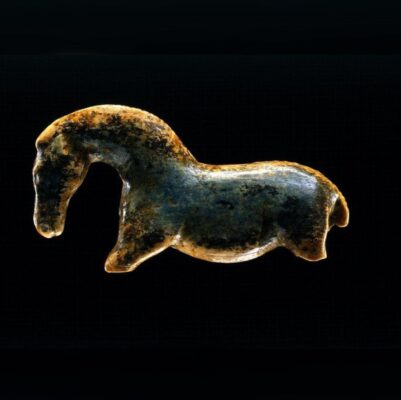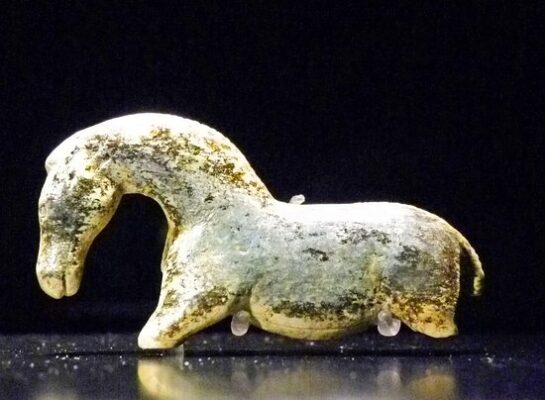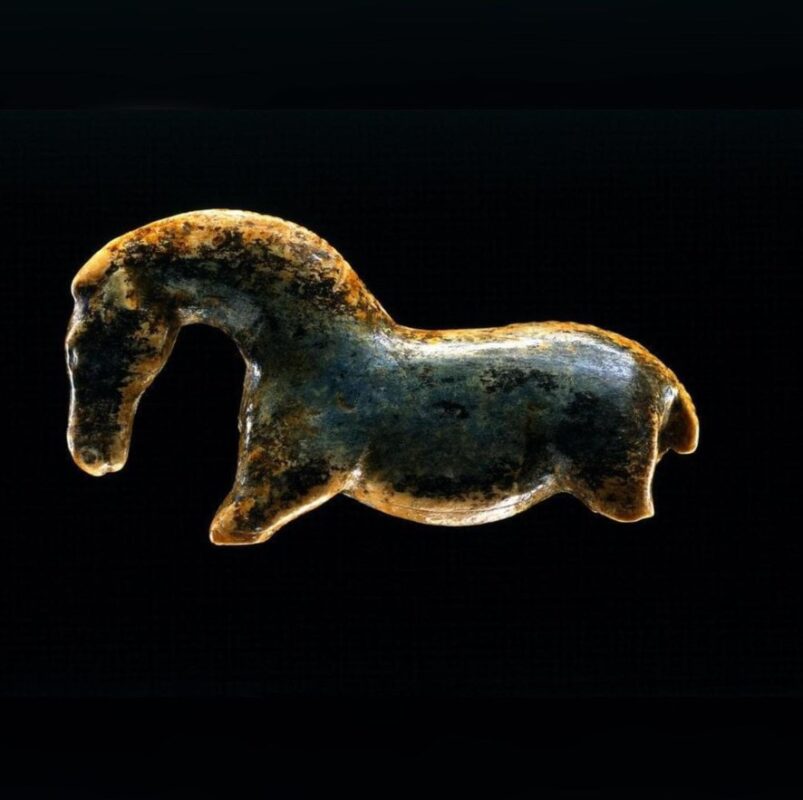1. Discovery of the Aurignacian Horse Sculpture
1.1. The Vogelherd Cave Find
The figurine was discovered in the Vogelherd Cave, a significant archaeological site in southwestern Germany. The cave has yielded several important prehistoric artifacts, and this horse sculpture stands out as one of its most exceptional finds.
1.2. Dating Back to 32,000-35,000 Years Ago
This mammoth ivory sculpture is believed to have been created between 32,000 and 35,000 years ago during the Aurignacian period. This places it within the Upper Paleolithic, a time when early humans began to develop advanced artistic techniques.
1.3. Significance of the Sculpture
The discovery of this horse figurine is a remarkable insight into the artistic abilities of Ice Age humans. It marks an early and sophisticated attempt to capture the form of animals, which likely had cultural, symbolic, or hunting-related significance.
See more: The Oseberg Ship A Masterpiece of Viking History
2. The Artistic Details of the Horse Sculpture
2.1. Crafted from Mammoth Ivory
The horse sculpture is made from mammoth ivory, a material that was commonly used by early humans for carving. This choice of material demonstrates the resourcefulness of the people at the time, as mammoth ivory would have been highly prized and carefully worked.
2.2. Well-Preserved Features
The sculpture is incredibly detailed, with its head being particularly well-preserved. The mouth, nostrils, and eyes are delicately engraved, showcasing a keen attention to anatomical accuracy. These features suggest that the sculptor aimed to create a lifelike representation.
2.3. Intricate Incisions and Carvings
The horse’s ears are finely sculpted, and its neck is beautifully arched. The body is adorned with crossed diagonal incisions along its mane, back, and sides, adding texture and depth to the sculpture. These markings likely enhanced the artistic expression and demonstrate the sculptor’s intricate craftsmanship.

3. The Cultural and Historical Importance of the Sculpture
3.1. Insight into Prehistoric Art
This horse sculpture is a testament to the cultural and artistic achievements of Ice Age humans. It provides valuable insight into the symbolic and aesthetic values of the time. The focus on animal representation indicates a deep connection with the natural world, possibly reflecting the importance of horses in early human societies.
3.2. Aurignacian Artistic Legacy
As a product of the Aurignacian culture, the horse sculpture contributes to our understanding of early human art. The Aurignacians are known for their cave paintings, carvings, and sculptures, which suggest that art played an important role in their daily lives and belief systems.
3.3. A Window into Prehistoric Symbolism
The creation of such sculptures may have had symbolic or ritualistic purposes. Early humans may have used these representations in spiritual practices, storytelling, or to signify power and strength. The horse, as an animal, could have held significant symbolic meaning for the people who created it.

Conclusion: A Monument to Prehistoric Craftsmanship
This extraordinary mammoth ivory horse sculpture is more than just an artifact; it is a link to our distant past, revealing the artistic talent, cultural beliefs, and historical contexts of Ice Age humans. The care and precision involved in its creation highlight the advanced skills of the Aurignacians and their ability to produce intricate works of art that still inspire awe today. As the oldest known sculpture of a horse, it remains an important testament to the ingenuity and creativity of our prehistoric ancestors.


CÁC TIN KHÁC
Mark Twain & Olivia Langdon: A 36-Year Love Story Filled with Laughter and Devotion
The Tollund Man: A 2,400-Year-Old Mystery Preserved in a Danish Bog
Skara Brae: Scotland’s Hidden Neolithic Village
Porta Nigra: The Hidden Depths of Trier’s Iconic Roman Gate